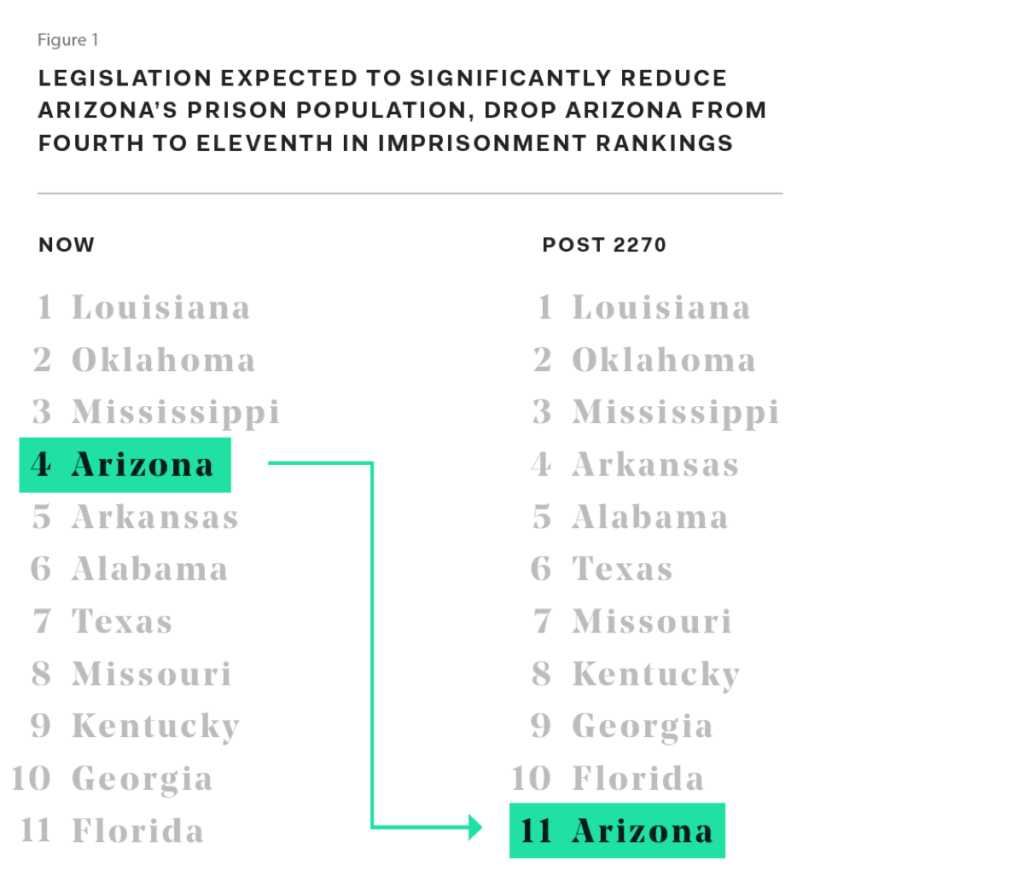House Bill 2270, legislation introduced in the 2019 session, is projected to shed Arizona’s title as one of the top 10 imprisoning states in the nation.1 The bill, sponsored by Representative Walt Blackman (R), would allow people to earn their way home from prison sooner by following the rules and participating in treatment and programming. The bill is projected to reduce the prison population by 8,300 beds — or 19 percent — by 2028. (For more on how these calculations were made, please see the methodology section.)
HB 2270 Will Move Arizona Out of the Top 10 Imprisoning States
Arizona has the fourth highest imprisonment rate in the U.S., but pending legislation could change that.
HB 2270 will move Arizona out of the top 10 imprisoning states

Background
After decades of prison growth, Arizona today has the fourth highest imprisonment rate in the country, meaning it puts more people in prison per capita than any other state — except for Oklahoma, Louisiana, and Mississippi.2 This growth has come with a hefty price tag. Arizona’s bloated prison population costs taxpayers over $1 billion each year without making the state safer.3
The size of Arizona’s prison population is largely due to its punitive sentencing laws. Arizona is one of only three states in the country that requires everyone in prison to serve at least 85 percent of their sentence, regardless of their behavior and readiness for release.4 Unsurprisingly, people in Arizona spend far longer behind bars than the national average, despite the fact that long prison sentences are ineffective as a crime control measure.5 At the same time, these long prison terms take Arizonans out of workforce and place emotional and financial burdens on the families of those incarcerated. People convicted of drug crimes in Arizona spend 40 percent longer in prison than the national average. For property crimes, people in Arizona spend almost twice as long in prison.
HB 2270 would allow people to earn time off their sentences for following the rules and participating in programming. People convicted of crimes not designated as dangerous in statute would be able to earn an additional 35 percent off their sentences. Most others could earn an additional 10 percent off their sentence. States across the country, including Mississippi (in 2009)6 and Louisiana (in 2017)7 have passed similar reforms, as well as the federal government as part of the “The First Step Act” (2018).8
Methodology
This impact analysis was conducted by FWD.us using individual-level data acquired from the Arizona Department of Corrections covering over 30 years and almost a half a million records. To project the impact of HB 2270, the following steps were taken:
- Arizona State Legislature, House Bill 2270, 2019 Regular Session, https://www.azleg.gov/legtext/54leg/1R/bills/HB2270P.pdf.
- Bureau of Justice Statistics, National Prisoners Statistics series.
- Arizona Legislature, “General Fund Operating Budget Spending Fiscal Years 1979 - 2019,” https:// www.azleg.gov/jlbc/gfhistoricalspending.pdf.
- American Friends Service Committee - Arizona, A New Public Safety Framework for Arizona: Charting a Path Forward, https://afscarizona.files.wordpress.com/2014/03/a-newpublic-safety-framework-for-arizona-december-2016.pdf.
- FWD.us, Arizona’s Imprisonment Crisis: The High Price of Prison Growth, https://www.fwd.us/news/arizona-imprisonment-crisis-part-1/; The Pew Charitable Trusts, Time Served: The High Cost, Low Return of Longer Prison Sentences, http://www.pewtrusts.org/-/media/legacy/uploadedfiles/wwwpewtrustsorg/reports/sentencing_and_corrections/prisontimeservedpdf.
- Mississippi State Legislature, SB 2039, 2009 Regular Session, http://billstatus.ls.state.ms.us/documents/2009/pdf/SB/2001-2099/SB2039SG.pdf .
- Louisiana State Legislature, Act 280, 2017 Regular Session, https://legiscan.com/LA/text/SB139/id/1635125.
- “First Step Act of 2018,” S.756 - 115th Congress (2017-2018), https://www.congress.gov/bill/115th-congress/senate-bill/756.
- A.R.S. §13-704.
- A.R.S. §13-705.

